6 Best Quad Stretches (with Pictures!)
Tight or sore quadriceps are a common complaint of both sedentary and active individuals.
Whether it be from a set of leg extensions the night before or too much time spent seated, performing quads-targeted stretches is absolutely vital.
Fortunately, we’re spoiled for choice when it comes to quad stretches. Even if you’re lying in bed, it is entirely possible to stretch the quadriceps in a static manner.
To stretch the quadriceps, the knee must be in a state of flexion so as to elongate the quadriceps - of which contract to perform knee extension. This means practically any stretch that involves drawing the shins and calves behind the body is technically a quad stretch.
How are the Quads Stretched?
The main biomechanical function of the quadriceps femoris is to stabilize and effect knee extension.

This means that, when activated, the quads are shortened when you straighten your leg. While activating a muscle is by no means bad for its function, doing it to an excessive degree or keeping the muscle in the same range of movement for too long can lead to stiffness and generally poor mobility.
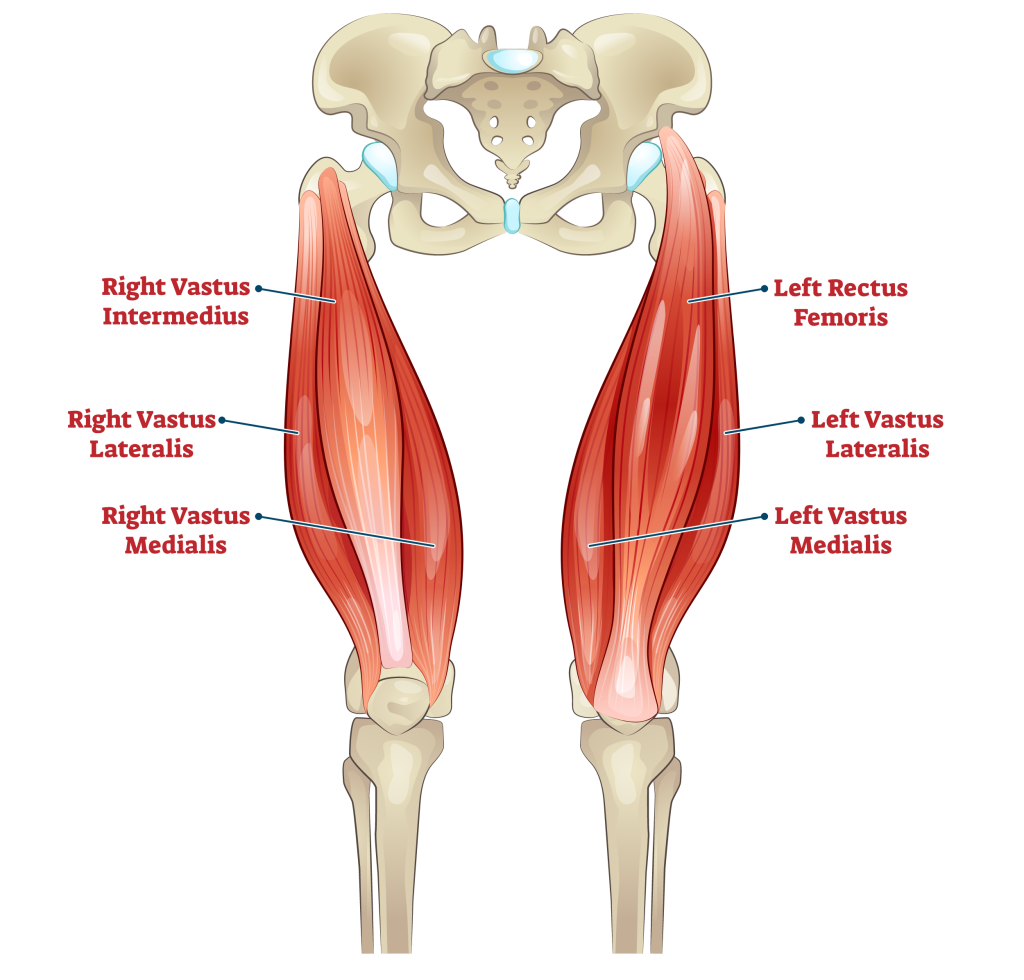
These issues are corrected by periodically lengthening the muscle to its fullest range, often with the use of specially designed exercises meant to reverse the effects of poor flexibility.
In the case of the quadriceps, performing stretches that specifically involve knee flexion (i.e. bending the leg at the knee) will subsequently lengthen the quads themselves.
Depending on whether this stretch is dynamic or static, the quads will either be kept stationary at the terminal point of their range of movement, or repeatedly moved through a somewhat smaller range.
Stretches for the Quadriceps (Quads)
1. The Standing Quad Stretch
The standing quad stretch is perhaps the most basic of quad stretches, requiring no equipment or advanced exercise knowledge.
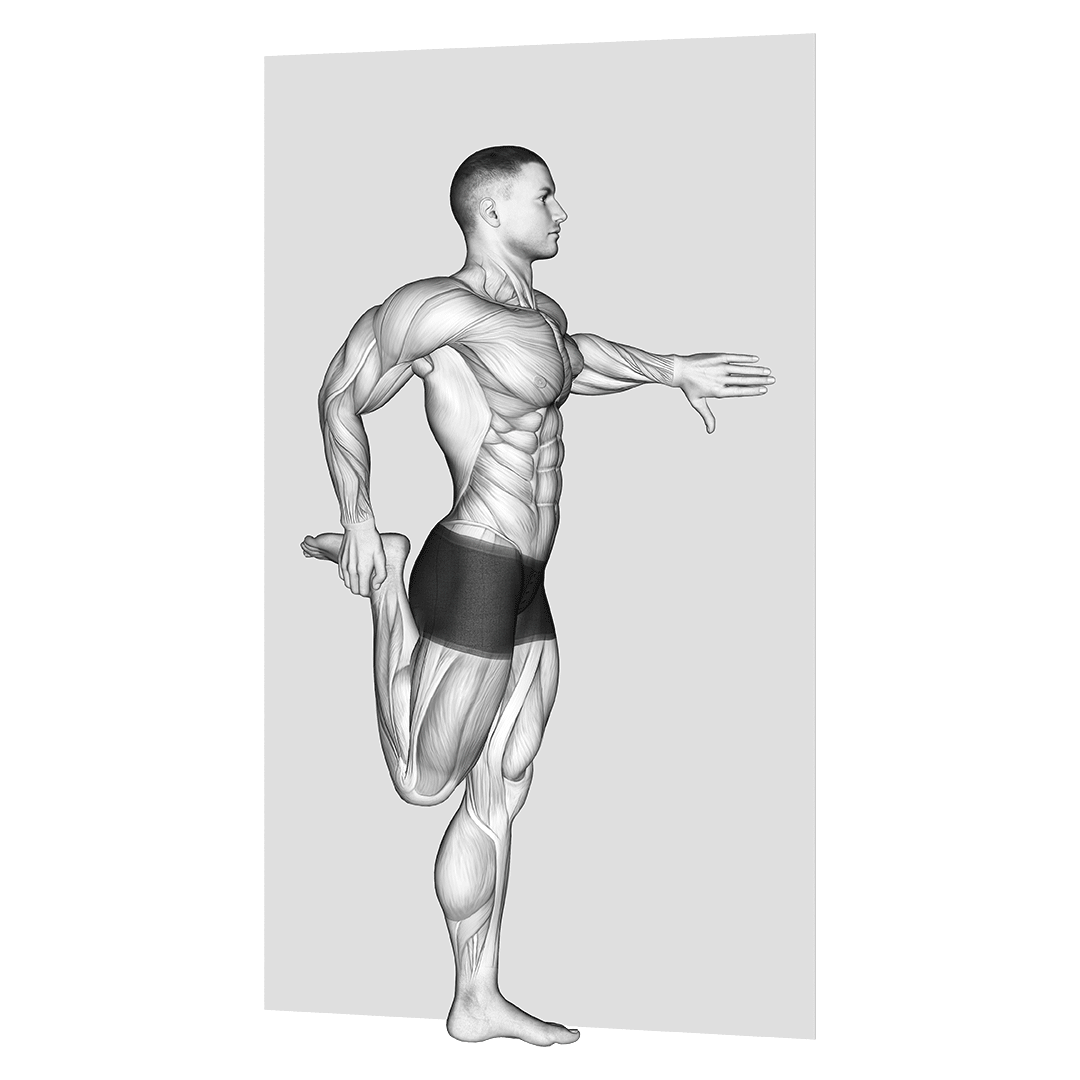
It is performed in a standing position and stretches one individual quadricep at a time. One hand may be used to help maximize how far the shin is bent behind the body.
Remember to perform the exercise with the assistance of a bench or wall if you have difficulty balancing on one leg.
Benefits as a Quadriceps Stretch
The defining benefit of the standing quad stretch is its simplicity and convenience. It is perfect as both a pre-workout stretch or as a component of a cool-off routine.
In addition, unlike other stretches such as the kneeling lunge or seated quadriceps stretch, standing quad stretches have no technical requirements and are completely appropriate for even novice exercisers.
How-to:
To perform a standing quad stretch, the exerciser will first stand on both legs with the feet wider than hip-width apart. One arm may be extended so as to help balance the body, if needed.

Then, raising one heel backwards towards the glutes, the exerciser will reach down with the hand of the same side and pull their ankle further back.
Once a light stretch is felt along the front of the thigh, the exerciser will hold position for up to half a minute before lowering their foot back down. Don’t forget to repeat the stretch with the opposite leg as well.
2. The Prone Quad Stretch
Also known as the front lying quad stretch - the prone quad stretch is performed with the exerciser lying on their stomach and reaching back so as to pull their heel towards their glutes.
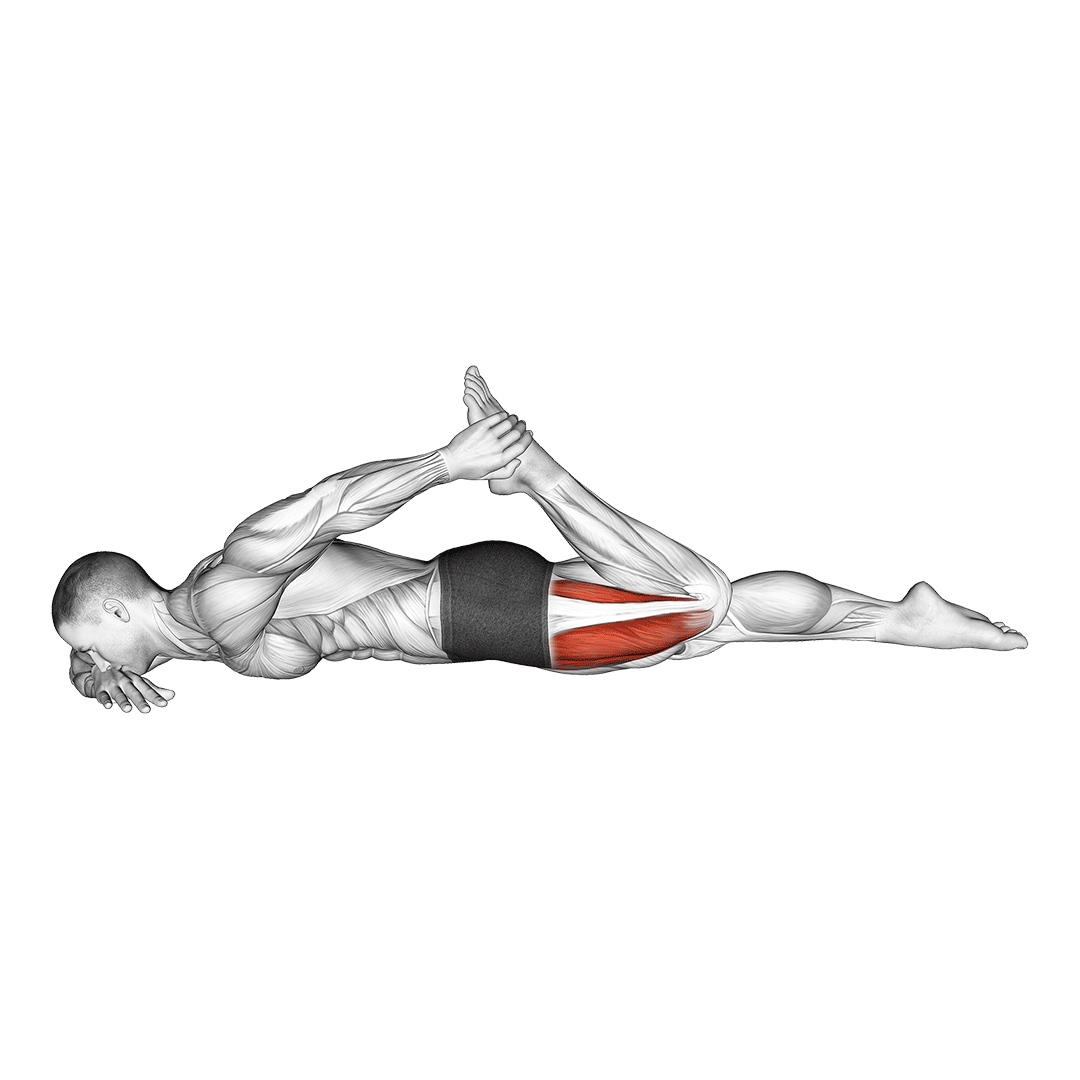
Those with poor mobility in the back or shoulders can instead wrap a towel (or resistance band) around their ankle as they perform the stretch. This will allow them to still maximize the length of their quadriceps without disengaging their position or being limited by poor mobility.
Benefits as a Quadriceps Stretch
Prone quad stretches have the benefit of being possible in a lying position. This makes them rather easy to perform at home, or otherwise as part of a mobility routine that includes other lying stretches or yoga poses.
Furthermore, the prone quad stretch allows the thigh to remain pressed against the floor as it is being performed - allowing for tension to be maintained in the quads as they are stretched.
How-to:
Lying on their stomach with both legs spaced hip-width apart, the exerciser will begin by raising their heel backwards until it is within reach of their arm on the same side.

The exerciser then reaches back (still facing the head forwards) and grips the ankle, pulling the shin further backwards until it is nearly touching the glutes.
A light stretch should be felt at the front of the thigh. Hold this position for up to 30 seconds before returning the foot to the floor and repeating with the opposite leg.
3. The Kneeling Lunge Stretch
Distinct from the kneeling quad stretch, kneeling lunge stretches are performed in a slightly more active fashion, generally replicating the stance of a Bulgarian split squat but with markedly greater hip extension.

Kneeling lunge stretches require some level of familiarity with maintaining a unilateral stance, but as a tradeoff will target certain hard-to-reach sections of the quadriceps (as well as the hip flexors) more effectively.
Individuals who find their knee feels painful or numb during this stretch can place a pillow beneath it for greater comfort.
Benefits as a Quadriceps Stretch
The kneeling lunge stretch is particularly effective at stretching the rectus femoris of the quads, as it will involve the exerciser extending the hips while in a split squat stance.
How-to:
To do a kneeling lunge stretch, the exerciser will first lower themselves to a half-kneeling stance by placing one knee on the floor with the other bent at the front. The foot of the downward-facing knee should be placed atop a block or exercise bench for a greater quadriceps stretch.

From this stance, the exerciser will orient their torso vertically, ensure they are properly balanced and then proceed to push their pelvis forwards, squeezing the glutes lightly.
This should create a stretching feeling along the middle and upper portions of the quadriceps. The knee should remain pressed into the floor with the opposite leg bearing most of the body’s weight.
Once the quads are sufficiently stretched, hold the position for up to 30 seconds. Switch to the opposite side.
4. The Kneeling Quad Stretch (Behind-the-Back)
The kneeling quad stretch is performed in a high lunge position so as to target the quadriceps tendon above the knee joint alongside other nearby muscle tissue.

As one can guess from its name, kneeling quad stretches are unilateral and will also target the hip flexors alongside the quads due to its high lunge stance.
As is also the case with the kneeling lunge stretch, the kneeling quad stretch can likewise be made more comfortable by padding the base of the knee. A pad, pillow or mat may be used.
Benefits as a Quadriceps Stretch
Kneeling quad stretches are excellent for targeting the lower section of the quadriceps and its ensuing connective tissue. Poor mobility in this area can lead to limited knee flexion and general instability when any movement involving the knees is being performed.
Furthermore, if planning to perform unilateral or staggered stance leg exercises like the split squat, the kneeling quad stretch is a perfect pre-workout static stretch.
How-to:
To perform a kneeling quad stretch, the exerciser begins by sinking into a kneeling position with one foot extended forwards and the opposite leg’s knee against the ground.
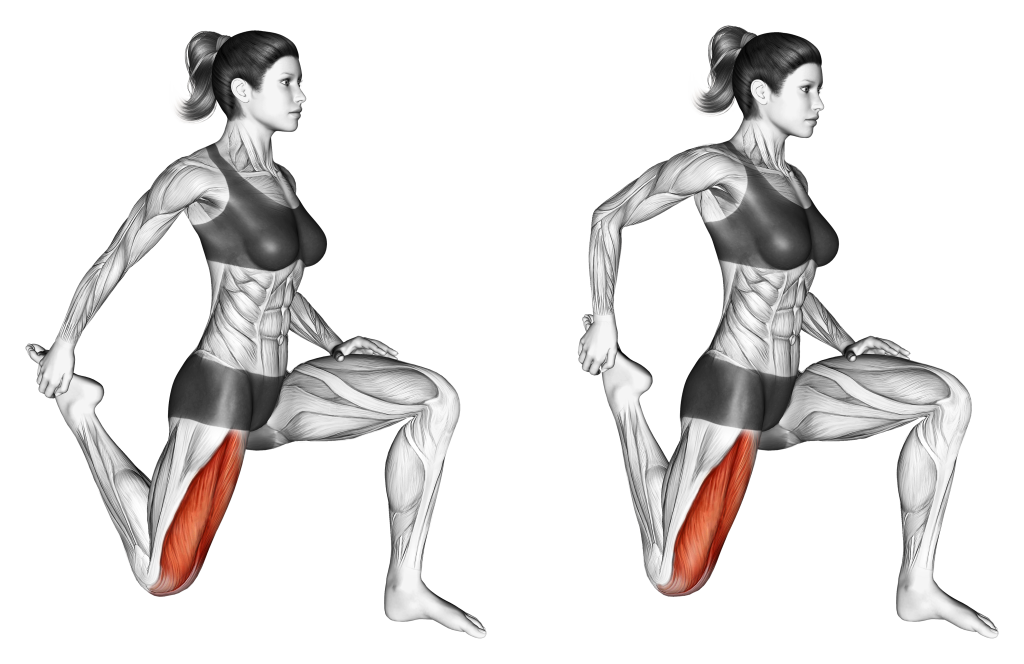
Shifting the body’s balance towards their standing foot, the exerciser then reaches back behind the bent knee and draws their foot towards their hip, keeping the torso upright and the head facing forwards as they do so.
Hold this position for up to 30 seconds before switching to the opposite side.
5. The Side-Lying Quad Stretch
Distinct from the prone quad stretch, the lying quad stretch places the exerciser on their side as they - once again - bend the shin behind the thigh, flexing at the knee.
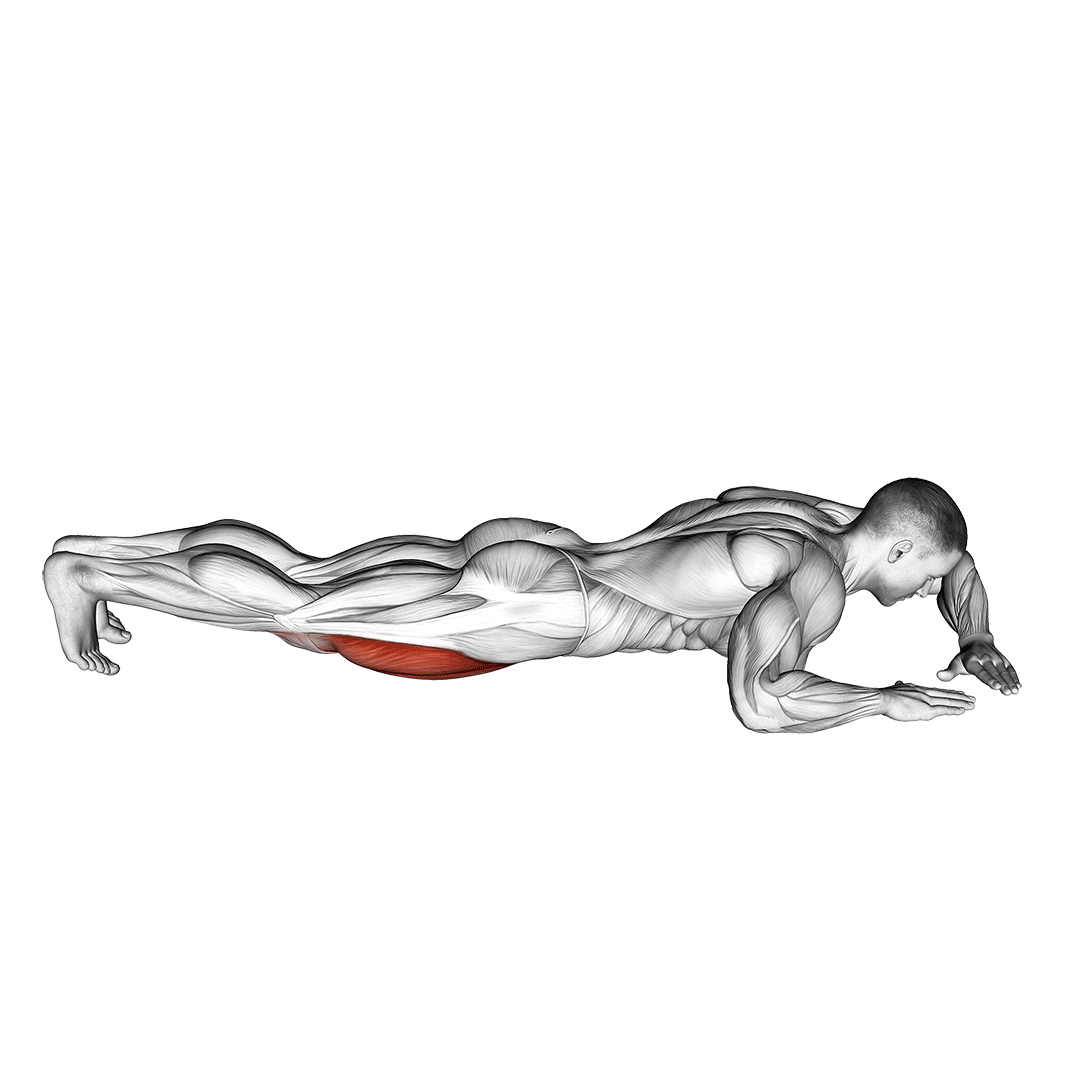
Side-lying quad stretches are often preferred over prone quad stretches due to the ease in which they are performed. Less mobility of the arms or back will be needed, and it is considerably easier for some individuals to lie on the side, rather than the stomach.
Benefits as a Quadriceps Stretch
The lying quad stretch shares much the same benefits as other lying quadriceps stretches - those being no need for balancing, the capacity to perform the movement at home and for individuals who cannot load their weight onto their knee.
If you are of the latter group, remember to first seek your doctor’s approval prior to attempting any movement of the legs.
How-to:
To perform a lying quadriceps stretch, the exerciser will lie on their side with either a pillow supporting their head or one arm pressed against the side of the skull.

Both legs should be extended parallel to the rest of the body, the leg to be stretched at the top.
Then, reaching down with the upper arm and bending the heel towards the glutes, the exerciser will grasp their ankle and follow the same motion until a stretch is felt at the front of the thigh.
Hold the position for 30 seconds. Turn over and repeat the same stretch with the opposite leg - of which should now be above the originally stretched leg.
6. The Seated Quadriceps Stretch
Although you may be picturing this stretch as being related to a chair or bench, it is actually performed in a half cross-legged position on the floor.

Rather than having both legs at the front of the body however, one is bent to the side so as to point the knee both backwards and laterally.
The seated quadriceps stretch is most useful for targeting the vastus lateralis and hip flexors. Greater hip flexor emphasis can also be created by pressing the opposite knee downwards as the stretch is performed.
Benefits as a Quadriceps Stretch
The seated quadriceps is markedly more convenient to perform than most lying quad stretches while simultaneously suffering from less disadvantages in comparison to standing quad stretches.
In addition, as mentioned previously, this particular quad stretch is excellent for working the vastus lateralis and hip flexors - both of which are often neglected in favor of the more prominent medialis and rectus femoris.
How-to:
Sitting on the ground with one leg bent to the side at the front of the hip, the exerciser then draws the opposite foot behind their hips, pointing the knee to the side. The head should remain facing forwards and the spine in a neutral curvature as this occurs.

The exerciser then pushes their hips forwards and reaches the arm of the same side as the bent leg backwards - gripping the foot and pulling it towards the glutes. A stretch should be felt at the top of the knee and the front of the pelvis.
Hold for up to 30 seconds. Repeat with the opposite leg as well.
Which Quad Stretch Should You Do?
In most cases, quad stretches are much the same. The sole difference is the position of the rest of the body during the movement.
If you’re just coming off a workout session or warming-up, then the standing quad stretch is the best simply because of how convenient it is. Other stretches like the lying, prone or seated stretch may be more appropriate for a lengthy mobility routine or if you are recovering at home.
As always, remember to first seek out medical advice prior to stretching an area you suspect to be injured. Sharp pain, numbness, tingling or poor knee function are all warning signs of an injury.
References
1. Lee JH, Jang KM, Kim E, Rhim HC, Kim HD. Static and Dynamic Quadriceps Stretching Exercises in Patients With Patellofemoral Pain: A Randomized Controlled Trial. Sports Health. 2021 Sep-Oct;13(5):482-489. doi: 10.1177/1941738121993777. Epub 2021 Feb 20. PMID: 33615901; PMCID: PMC8404765.
2. Haff GG, et al. “Warm-up and flexibility training.” Essentials of Strength Training and Conditioning. 4th ed. Colorado Springs, Colo.: National Strength Training and Conditioning Association; 2016.
